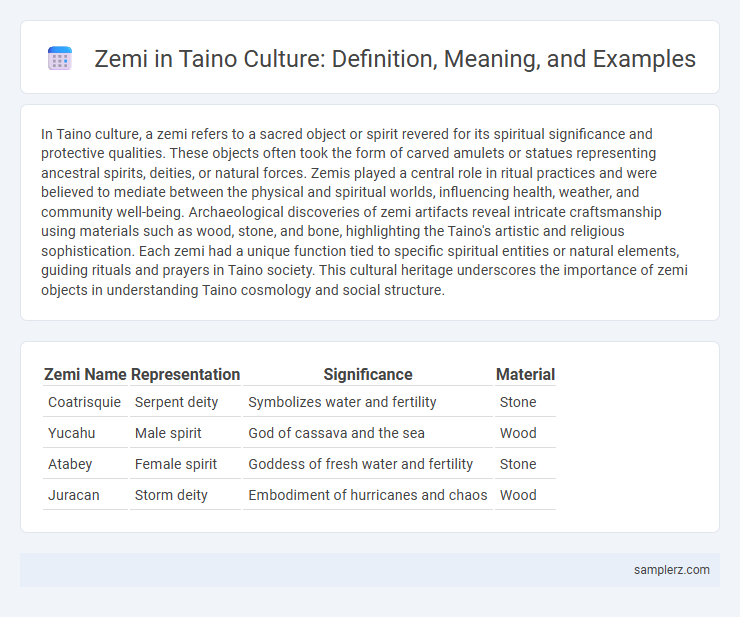In Taino culture, a zemi refers to a sacred object or spirit revered for its spiritual significance and protective qualities. These objects often took the form of carved amulets or statues representing ancestral spirits, deities, or natural forces. Zemis played a central role in ritual practices and were believed to mediate between the physical and spiritual worlds, influencing health, weather, and community well-being. Archaeological discoveries of zemi artifacts reveal intricate craftsmanship using materials such as wood, stone, and bone, highlighting the Taino's artistic and religious sophistication. Each zemi had a unique function tied to specific spiritual entities or natural elements, guiding rituals and prayers in Taino society. This cultural heritage underscores the importance of zemi objects in understanding Taino cosmology and social structure.
Table of Comparison
| Zemi Name | Representation | Significance | Material |
|---|---|---|---|
| Coatrisquie | Serpent deity | Symbolizes water and fertility | Stone |
| Yucahu | Male spirit | God of cassava and the sea | Wood |
| Atabey | Female spirit | Goddess of fresh water and fertility | Stone |
| Juracan | Storm deity | Embodiment of hurricanes and chaos | Wood |
Understanding Zemi in Taíno Spiritual Beliefs
Zemi in Taino culture represents sacred objects embodying ancestral spirits and deities, crucial for spiritual rituals and community guidance. These intricately carved figures, often crafted from wood, stone, or bone, served as intermediaries between the physical world and supernatural forces. Understanding Zemi reveals their role in protection, fertility, and health, illustrating the deep spiritual connection within Taino beliefs.
Types of Zemi: Spirits, Deities, and Ancestors
Zemi in Taino culture encompasses a diverse array of spiritual entities including powerful deities, ancestral spirits, and nature spirits integral to religious practices. Deities such as Yucahu, the god of cassava and fertility, and Atabey, the goddess of freshwater and motherhood, are central figures represented in intricately crafted zemi idols. Ancestor veneration is reflected through zemi artifacts serving as physical connections to forebears, embodying wisdom and protection within Taino communities.
The Role of Zemi in Taíno Daily Life
Zemi in Taino culture functioned as sacred objects embodying spirits believed to influence daily life, health, and agriculture. These stone or wooden figures served as mediators between the physical and spiritual worlds, guiding community decisions and rituals. Taino people entrusted their well-being and protection to zemis, highlighting their central role in social cohesion and cultural identity.
Artistic Depictions of Zemi in Taíno Artifacts
Zemi are sacred Taino objects representing ancestral spirits and deities, often crafted from wood, stone, and bone with intricate carvings. These artistic depictions display stylized humanoid faces with geometric patterns, embodying spiritual power and cultural identity. Taino zemi artifacts reveal the civilization's sophisticated artisanship and profound connection to their cosmology through symbolic and ritualistic designs.
Zemi Rituals: Worship and Offerings
Zemi rituals in Taino culture involved intricate ceremonies to honor ancestral spirits represented by sculpted zemi figures, often crafted from wood, stone, or clay. Offerings such as cassava bread, tobacco, and coconut were presented to these sacred idols to ensure fertility, protection, and harmony within the community. These rituals reinforced spiritual connection and social cohesion, reflecting the central role of zemi worship in Taino religious life.
Zemi and Leadership: The Cacique’s Connection
The Zemi in Taino culture served as sacred objects representing ancestral spirits and deities, playing a crucial role in the leadership and spiritual authority of the Cacique. These carved figures were believed to grant protection, guidance, and legitimacy to the Cacique's rule, symbolizing the divine connection between the leader and the community's spiritual world. The Cacique's ability to communicate with the Zemi reinforced social order and ensured the well-being of the Taino people.
Zemi in Taíno Creation Myths
Zemi in Taino culture represents powerful ancestral spirits integral to creation myths, embodying natural forces and deities responsible for the world's origin. In Taino creation myths, zemi figures like Yucahu, the cassava god, and Atabey, the mother goddess, play central roles in shaping the cosmos and guiding human life. These spiritual icons symbolize fertility, agriculture, and the interconnectedness of nature and humanity in Taino belief systems.
Sacred Materials: Crafting Zemi Idols
Zemi idols in Taino culture were meticulously crafted from sacred materials such as wood, stone, bone, and cassava fibers, each chosen for its spiritual significance and durability. These objects embodied ancestral spirits and deities, serving as powerful intermediaries in rituals and daily life. The intricate carvings and symbolic motifs on zemi idols reflected cosmological beliefs, reinforcing their role as vital components of Taino religious and cultural identity.
Preservation of Zemi Traditions in the Modern Caribbean
Zemi, sacred Taino objects representing ancestral spirits, play a crucial role in the preservation of indigenous culture in the modern Caribbean. Contemporary artisans and cultural organizations actively reproduce and honor zemi sculptures to sustain Taino identity and spiritual practices amid globalization. Efforts in Puerto Rico and the Dominican Republic include educational programs and exhibitions that highlight zemi symbolism, ensuring the continuity of these traditions for future generations.
Archaeological Discoveries of Zemi Figures
Archaeological discoveries of zemi figures in Taino culture reveal intricate carvings in wood, bone, and stone, embodying spiritual beings and ancestral spirits. These zemi artifacts, often found in ceremonial sites such as caves and ball courts, illustrate the Taino's complex religious beliefs and social organization. Radiocarbon dating situates many of these figures between 1200 and 1500 CE, underscoring their significance in pre-Columbian Caribbean spirituality.

example of zemi in Taíno culture Infographic
 samplerz.com
samplerz.com